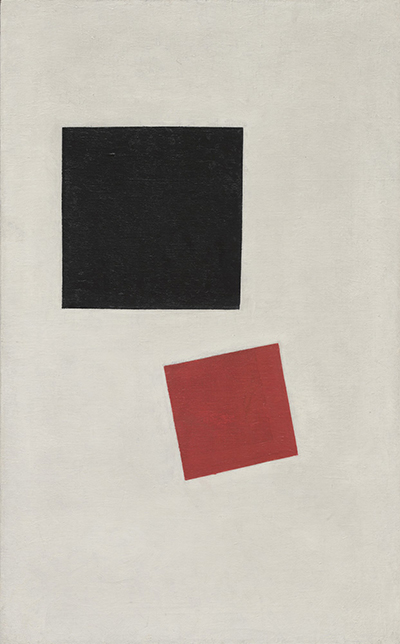Painterly Realism of a Boy with a Knapsack - Color Masses in the Fourth Dimension is a painting from 1915 by Russian abstract artist, Kazimir Malevich. It is amongst his most simple artworks of all, featuring just two rectangles upon a blank background.
Malevich produced many different iterations along the same style of abstract shapes that would be arranged in different ways in order to communicate and symbolise different meanings. In this example he places a large black rectangle in the top left corner with a small red shape then placed below, slightly angled to the left. The rest of the painting is an off-white which would have been painted by hand rather than being from the original paper or canvas. Those fortunate enough to view Malevich paintings up close will notice brushwork even in these blocks of colour, where small variations can be seen up close. The painting arrived in 1915 and this followed on shortly after the artist had been working with other styles, but was now fully committed to his conversion to abstraction. You will find many other similar artworks with bizarre titles from the same year, such as Airplane Flying (Suprematist Composition) and Malevich would work with this approach exhaustively, choosing to stick with it longer than with his entries into Cubism, Impressionism and Fauvism.
Painterly Realism of a Boy with a Knapsack - Color Masses in the Fourth Dimension was unveiled in late 1915 at an exhibition in St Petersburg. His new approach to art was groundbreaking but would inevitably cause controversy just as soon as the paintings were put out on display. Suprematism was the title given to the overall style and this was due to Malevich claiming this approach to be superior to nature. The artist would write several comments upon some leaflets which he distributed at the exhibition in order to better explain this new approach, though it is unlikely that this would have sufficed for some of the more traditionally minded critics. For related artworks, see also Suprematist Composition (Blue Triangle and Black Rectangle) and Self-Portrait in Two Dimensions. The artist would describe this approach of achieving a zero of form, where he would start from scratch and create an entirely new artistic direction, pushing away traditional art and encouraging an entirely new way of thinking.
This painting can today be found in the permanent collection of MoMA in the US, which remains one of the best places to learn and discover contemporary art anywhere in the world. The institution currently has around 60 items from his career in total, some of which includes cartoon drawings and manuscript covers from his career, as well as other related paintings from across the 1910s. It is quite probable that a large proportion of these artworks were donated or purchased in groups together from collectors as it would not have been possible to obtain each of them separately, considering how many are part of series of works. Malevich was important in both the west as well as Russia, making it entirely necessary to include him prominently within MoMA's collection. New York based collectors will sometimes bequeth elements of their possessions to this exceptional venue, perhaps as a thank you for being able to visit the location themselves from time to time.




